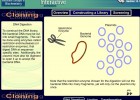Cargando...
Recursos educativos
-
Nivel educativo
-
Competencias
-
Tipología
-
Idioma
-
Tipo de medio
-
Tipo de actividad
-
Destinatarios
-
Tipo de audiencia
-
Creador
-

Game: Immune system
Tiching explorer Organización
- 3524 visitas
In this game we learn tat granulocytes, macrophages and dendritic cells are immune cells specialized in finding and "eating" bacteria, viruses, and dead or injured body cells.
-

Initial evaluation 2 - The Diversity of Life
EduBook Organización
- 2179 visitas
Complete the following sentences with the missing words: Bacteria belong to the kingdom of living things. are made up of only one cell. Algae produce from the process of photosynthesis. Mould is a type of .
-

Classifica organismes
EduBook Organización
- 2136 visitas
Observa les fotos dels següents organismes i classifica'ls en procariotes o eucariotes. En què et bases per a fer aquesta diferenciació? Bacteria: Helicobacter pylori. Amfibi: granota. Protozoo:…
-

Clasifica organismos
EduBook Organización
- 1957 visitas
Observa las fotos de los siguientes organismos y clasifícalos en procariotas o eucariotas. ¿En qué te basas para hacer esta diferenciación? Bacteria: Helicobacter pylori. Anfibio: rana. Protozoo:…
-

Initial evaluation 1 - The Diversity of Life
EduBook Organización
- 1892 visitas
Are the following sentences true or false? Fungi are a type of plant. Bacteria are unicellular organisms. Protozoa are very small animals. All dogs belong to the same species.
-

The discovery of antibiotics
EduBook Organización
- 4332 visitas
In 1928, Alexander Fleming, a Scottish doctor working in a hospital in London, discovered the first antibiotic by accident. Fleming was studying cultures of Staphylococcus bacteria, which he was growing…
-

Interpreta un experimento
EduBook Organización
- 2563 visitas
Cuando una bacteria no crece o cuando se muere en presencia de un antibiótico, se dice que es sensible a este antibiótico. Y al contrario, si su crecimiento no se ve afectado por el antibiótico, se…
-

Video: Cloning tutorial
Tiching explorer Organización
- 5027 visitas
This lesson presents us with a problem: we created an antibiotic but a culture of staphylococcus proves resistant to it. We want to clone the antibiotic-resistance gene that encodes a newly acquired…
-

Calcula. La reproducción bacteriana
EduBook Organización
- 3608 visitas
Una especie de bacteria se divide una vez cada hora si tiene espacio y alimento suficiente. Calcula el número de bacterias que se pueden formar a partir de una sola célula en 12 horas. Número de…
-

As moneras
EduBook Organización
- 3335 visitas
3.1. As moneras As arqueobacterias, ou bacterias máis arcaicas, as bacterias e mais as algas cianofíceas ou cianobacterias, constitúen o reino moneras. As algas cianofíceas poden vivir illadas ou en…
Te estamos redirigiendo a la ficha del libro...













